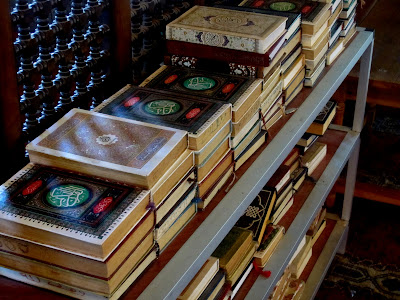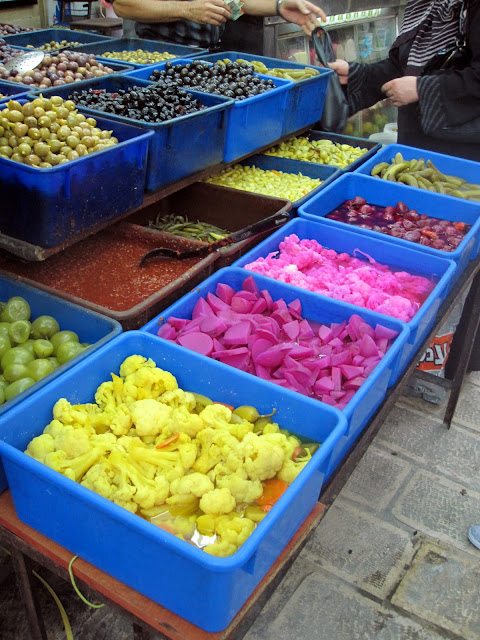
Last year we were in Sevilla for three months and we feel most fortunate to be able to end our tour of the Wine Dark Sea here.
 |
| Ronda |
Number 10.
The Andulucian Region While Sevilla is the capital of this region, there are numerous interesting places near here for a break from the sensory overload of the old city. The Roman ruins of
Italica, the 3rd largest after Rome and Alexandria, is only a few kilometers from here by bus.
Jerez, the home to dozens of sherry producers (the Castillian word Jerez comes from the Arabic Sherish), is an hour's drive.
Los Pueblos Blancos, east of Sevilla, are small villages on hilltops with stunning views of the plains below.
Ronda is perhaps the most famous. Their whitewashed buildings make them stand out as you drive across the country towards
Cordoba or
Granada, home to the famed
Alhambra.
 |
| A University Singing Club |
Number 9.
The "Old" City The city center of Sevilla sits in a bend in the river Guadalquiver. And the "historic district" is not a distinct area surrounded by a modern city, but rather the historic district
is the downtown of Sevilla. It is a maze of alley-sized walking streets. A few allow cars, but you don't find in the center any confusion or noise from car, motorcycle, scooter or bicycle traffic. It is a
walking city filled with tapas bars, cafes, small shops and apartments with roof-top terraces.
What is particularly remarkable is that this city has not suffered a single destructive war or conflict since the Christians recaptured the city from the Moors in 1248 (after almost 500 years as a major Moorish center) . Few cities in Europe are able to claim that they have avoided the wars which leave blocks and blocks in rubble. Many buildings and monuments remain from the Moorish period
.
 |
| Parading past the garbage swallowers |
Number 8. The Garbage Disappears Not sure where it goes, but most of the plazas have these submarine-like turrets which swallow up the live garbage. There must be an extensive underground system of tunnels, but we aren't particularly interested in taking the tour. Above ground are bins for glass and paper recycling.
 |
| The smallest plaza in the city |
Number 7.
Architecture and Plazas Anyone who loves puzzles would love the layout of this city. While historians say that a series of alleys were built to deter intruders, in modern times it makes for interesting walking and countless stops for photo ops. Colorful tile and orange trees are found everywhere. Very few modern structures clash with the classic "Southern Spanish Look." Graceful arches lead to stately public buildings, homes with interior courtyards seen only from street front doors momentarily left ajar--- it is a wonderful place to get lost and wonderful fun to find your way out again to a familiar plaza. What the Romans and Moors began, the Spaniards only improved upon.
 |
| Plaza de Espana, perhaps the largest plaza in Sevilla |
 |
| Triana Bridge |
 |
| Tio Pepe, one of the Jerez sherry producers |
Number 6.
Wine Oh, let us count the ways! Sevilla is first of all in the region that produces sherry. Not that sweet sipping kind -- it is exported to England, where they truly appreciate it. We're talking fino, manzanilla, amontillado or oloroso generally dry, and rather something in a class all their own. They are served chilled and complements tapas perfectly. We have also discovered a myriad of Spanish tintos (reds) from Rioja and Ribera del Duero, that again go wonderfully with the local food. Many are 5 Euros or less per bottle.
 |
| Passion of the Flamenco |
Number 5: Music The breadth of the musical scene is remarkable. We have been to symphony concerts in the magnificent modern concert hall, Teatro la Maestranza. We have enjoyed sweaty, jam-packed, late night flamenco singing and dancing for the price of a beer. Also the haunting, chamber music recitals in baroque gilded churches are some of our favorite memories. The University of Sevilla sponsors weekly concerts at the Iglesia de la Anunciacion, just a few blocks from our apartment. This week we enjoyed the university symphony from Uppsala, Sweden, probably about 100 players. This group, founded in the 1600s, draws from the university students and faculty at large -- generally not from the music department. A Swedish composer of one of the pieces was in the audience. Just another weekly free event minutes away.
 |
| A Baroque Violin Recital |
 |
| The Cathedral and La Giralda |
Number 4. The Bells. The city is full of churches and sunset on our rooftop patio with snacks and a bottle of wine is perfect for listening to the concert of church bells as they call people to mass. At the center is the third largest Christian cathedral, after St Peter's in Rome and St Paul's in London. The cathedral's tower, the symbol of the city, was formerly a minaret, and is called
La Giralda. The access to the bell tower is by means of a ramp, not stairs. The ramp allowed horses to carry the prayer caller to the top. Our apartment is five minute walk from the cathedral and a stone's throw from the second largest church in Sevilla,
Iglesia del Salvador.

Number 3.
Daily Fresh Food Markets The closest to us is at
Plaza Encarnacion, which has been under construction for years, maybe for decades. They are building a collection of huge, round towers, locally referred to as "the mushroom" and perhaps someday we will return to see what it does other than cover the market area. Today the market is hidden in a back corner waiting for completion of the mushroom. The alternative is a 15 minutes walk across the river to the neighborhood of Triana and a wonderful indoor collection of vendors selling the freshest and most beautiful fruit, vegetables, meat, fish, cheese, sweets and all sorts of delicacies. At a tapas bar in the market, when you order the waiter scurries to a nearby stall to pick out and purchase the ingredients.
 |
| Salmon and Vegetables Tapa |
Number 2: Tapas The story we heard was that King Alfonso X was concerned about the consumption of alcohol by his constituents, and therefore decreed that each glass of wine or beer had to be accompanied with a slice of ham or chorizo, placed over the glass. From this the tradition of "tapas" or "lids" has overtaken the city. Probably our favorite is mambru, a concoction of toast, fig jam, aged goat cheese, caramelized onions and drizzled with balsamic honey reduction.
Sevilla has a city wide contest of serious proportions -- each little bar and cafe has a specialty of some fresh, tasty treat sold either as a small plate (a tapa) or a entree (a racion). Last weekend we had tortilla de camarones and chanquetes con huevos fritos y pimentos. That translates to a crispy thin fritter, the size of a saucer and made with whole small shrimp, and a plate of tiny fried fish mixed with a fried egg and roasted red peppers.
 |
| Our Favorite Neighborhood Bar - La Bodega Alfalfa |
Number 1. Style This one is tough to capture. There is a grace and beauty to Sevilla. You start with the mix of Moorish and Christian cultures, throw in the horse-breeding, wealthy farmers and add a sense of pride and well-being. Walking Sevilla on a weekend afternoon you see everywhere families with mothers and daughters walking arm in arm, outdoor cafes filled with relaxed coffee drinkers reading the newspaper and plazas where old and young meet to enjoy a beer while standing at small, tall, round tables. It's picture post-card perfect!
.





























